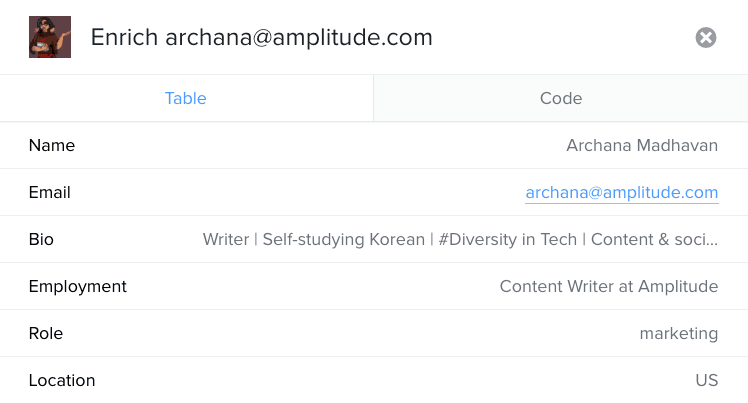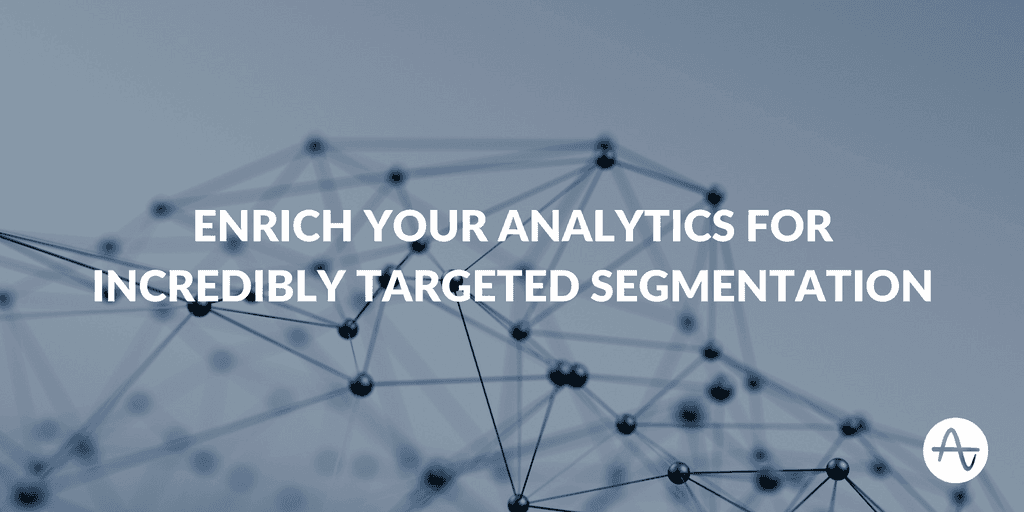Enrich Your Analytics for Incredibly Targeted Segmentation
By combining enrichment and analytics you can access all of the information about your customers. This will help you understand exactly who they are and exactly what they want from your product.
We’re all for MOAR DATA here at Amplitude. The more you’ve got, the better you will understand your customers, your product, and the journey the former take through the latter. Within Amplitude, you can find out exactly what your customers are doing in your app. But it’s difficult to work out who these customers are from pure behavioral data. Once you know who your customers are, you can know what they value, what they need, and what they expect from you. All of this information can come from your behavioral analytics, but having that initial insight into your customers through data enrichment makes everything else a lot easier. You can build a complete picture of your customers and segment, target, and communicate better with each individual. By combining enrichment and analytics you can access all of the information about your customers. This will help you understand exactly who they are and exactly what they want from your product.
Marrying enrichment and analytics has just been made a whole lot easier through Segment’s new enrichment integration category. Now you can use Segment as the hub for passing enriched data from enrichment API Clearbit directly into Amplitude—all through just a few clicks. Source: Clearbit You can read more about how this works here. But, briefly, when a new user signs up for your site, Segment collects the user’s email address and sends it to Clearbit. Clearbit then uses data from around the web to enrich the profile with personal and company information. This data can then be piped directly into Amplitude to be used in your analytics. Adding this information to your data tells you who your customers are, how well you’ve engaged specific segments, what industries customers represent, and what they want from your product. You might be surprised by what you find.

You don’t know your customers as well as you think you do
If you’re already using Amplitude, you probably know a lot about your customers. You know exactly what they are doing in your app, what they like and dislike, what inspires them to stay and what drives them to leave. But you can still be missing a ton of data. What companies do they work for and where are they located? What industries are they in and what are their roles? Are they from enterprises or startups? Are they bootstrapping or venture-backed? The purpose of enriched data is to fill in the blanks where your data lags. If you have built ideal customer profiles or buyer personas for each customer, this is exactly the type of information you need to validate your hypotheses. You may think that you are attracting your ICP targets, but are they the people that are really coming through the door? Without enrichment, this is a guessing game. [Tweet “The purpose of enriched #data is to fill in the blanks where your data lags.”] You can get some of this information through long signup forms that ask for role, company size, and industry, but these hurt your conversion rate. Segment themselves saw a 23% bump in signups when they went for frictionless signup. Data enrichment can get all of this information and more through an email address. Getting both conversions and data is only possible through enrichment. For instance, if someone from Amplitude signed up for your product using their @amplitude.com address, you could get all this information about the company:
"company": { "id": "ee80e89e-cf45-4e0a-84cf-0d98a74aee49", "name": "Amplitude", "legalName": "Amplitude Inc", "domain": "amplitude.com", "url": "http://amplitude.com", "site": { "url": "http://amplitude.com", "title": "Amplitude | Web and Mobile Analytics", "h1": "Discover user insights for building better products", "metaDescription": "Amplitude is a web and mobile analytics platform that helps you build better products. Discover user behavior insights about retention, engagement, and revenue.", }, "category": { "sector": "Information Technology", "industryGroup": "Technology Hardware & Equipment", "industry": "Communications Equipment", "subIndustry": "Technology Hardware, Storage & Peripherals" }, "tags": [ "Mobile", "SAAS", "B2B", "Information Technology & Services", "Technology", "Software" ], "description": "Amplitude is a web and mobile analytics platform that helps you build better products. Discover user behavior insights about retention, engagement, and revenue.", "foundedDate": 2012, "location": "185 Berry St #5425, San Francisco, CA 94107, USA", "metrics": { "alexaUsRank": 22034, "alexaGlobalRank": 42456, "googleRank": 2, "employees": 44, "marketCap": null, "raised": 26000000, "annualRevenue": null } } }
From that, you would know that the person who has just signed up for your product:
- works in “Mobile,” “SaaS,” and “B2B” industries
- is located in the Bay Area
- comes from a venture-backed company
- comes from a small company
Suddenly you’ve got a wealth of targeting data even before customers have started using your product. This is all information that was missed previously when each new user was treated as an identical datapoint. Not only does this data give you a richer understanding of each customer, but now it also opens up the possibility to segment and target your customers better for conversion, retention, and upgrades.
One size never fits all (and that’s okay)
Every single company knows that each customer will use their product differently. Some will be there for feature X, others for feature Y. For some, it will be an always-open, can’t-live-without-it tool. For others, it will be something they drift to and from. Once your customers start using your product, you can know which bucket they are going to fall into through your behavioral analytics. You can then guide them through the process, get them to the “Aha” moments for their segments, and increase retention. Behavioral analytics is all about giving customized experiences to different cohorts so that they are getting the greatest value from your product. With enrichment you can move this customization a step forward. Instead of waiting for behavior, you can use the correlations between different enriched profile characteristics and behaviors to start nudging customers towards their “Aha” moments from the get-go. For instance, say you marked every company with fewer than 100 employees (like Amplitude) as a “startup” and you marked every company with over 1,000 employees as an “Enterprise.” It is obvious that each of these types of companies will want different value from your product. (Source: Lean Analytics Book) Say you are building a marketing tool. A startup company is looking for traction and to gain new customers quickly. An enterprise company is looking to help their existing customers as much as possible. Startups favor acquisition, enterprises favor retention. If this information is available to you from the moment of signup, then the very first page your customer sees can be customized:

- Startup companies can be shown product tours of how to use your demand generation features and content on how to leverage email, mobile, and social for leads.
- Enterprise companies can be directed to information on account-based marketing and on how to use marketing automation to make sure you are deepening your customer relationships, leading to upsell.
From there you can start to dig in, using your analytics to deepen your understanding of each of these cohorts. You will already have seen that this is what these different customers want through their behaviors in-app. Now you’re just getting value to them quicker and starting your analysis sooner. It makes sense to start with broad categories (startup vs. enterprise), but there is no reason to stop there. Within companies you can start to look at who is signing up for your product. If I signed up, then you might get this information from Clearbit: If you are customizing like a pro, you’d know that the landing page I see next, and the first email I get, should concentrate on how you help marketers (and could possibly be written in Korean). Automation and efficiency is effectively what tech is all about, but that doesn’t mean everything should be the same. Ideally, every interaction you have with a customer should be a tailor-made, unique interaction. Enrichment + behavioral analytics lets you get closer to this ideal.

Data is only as good as the campaigns you build around it
Everything should be geared towards giving more back to your customer. Data for data’s sake is pointless. The enriched profile information is the starting point for a better customer experience, but it is still up to you to use that data wisely and give them what they want. If enterprise customers are coming to your product but not staying, start to use this information to ask why:
- Can you get them to that “Aha” moment quicker?
- Can you build more features that are particular to their use-case?
- Can you provide more content on how they should be using your product to find success?
Compare and contrast different segments to determine what’s lacking. You might discover that: - Their high-level usage requires more onboarding than just a quick product tour.
- Your feature set is missing a mission-critical factor for enterprise.
- They want content backed by input from industry leaders.
Constantly refer back to your data to tailor campaigns. Not doing so wastes your time and drives your customers away. Once you start to understand what this segment wants and needs, personalize your targeting. If maximizing retention of your high-value segments is most important to you, offer one-on-one customized onboarding with your customer success team to get them up to speed quickly. Once you’ve got them, start a series of industry webinars that help everyone using your product succeed. Be as fluid as possible so that once a concern is identified you’re in the position to roll out a solution quickly. Whether it’s providing more online tools, more content, or more personalized service, figure out what it is and get to work.
Putting this into practice
Enriching your data with your customers’ personal and company information is now easier than ever. With literally just a few clicks, you will open up a treasure trove of useful data that you were previously missing. Coupling this to your behavioral analytics within Amplitude means that you can segment, target, and customize even earlier, offering an even better experience. Explore tools that enable you to power up general customer data and segment the results. Enriched data lets you fine tune your engagement strategies and spend less money in the long run. Nothing beats highly targeted campaigns. Take the time to get into your customers’ mindset and understand who they are so that you’re in tune with what they expect from you. You stand to become the company they turn to by providing what they need before they even realize they need it. Taking the extra step to enrich data will unlock endless possibilities. [Tweet “Taking the extra step to enrich #data will unlock endless possibilities.”]
Comments
Alex Metier: How do you deal with the privacy law when both Segment and Amplitude clients enrich their customer data with PII information?

Archana Madhavan
Senior Learning Experience Designer, Amplitude
Archana is a Senior Learning Experience Designer on the Customer Education team at Amplitude. She develops educational content and courses to help Amplitude users better analyze their customer data to build better products.
More from Archana




